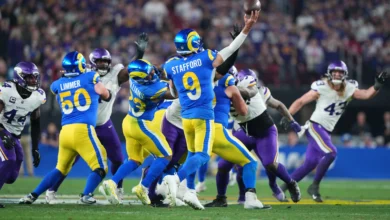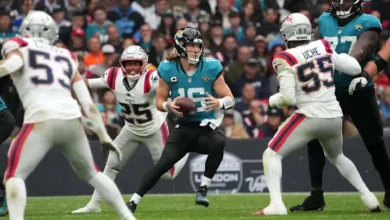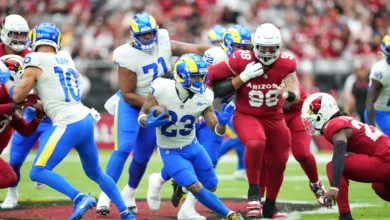Kansas City Chiefs vs Atlanta Falcons Match Player Stats – A Complete Breakdown

When the Kansas City Chiefs meet the Atlanta Falcons, football fans are treated to an exciting clash between two franchises that represent different conferences, different histories, and different playing styles. Although these teams do not meet often due to being in separate conferences — the Chiefs in the AFC and the Falcons in the NFC — every time they do, it provides fresh storylines, dramatic moments, and most importantly, player stats that tell the real story of the matchup.
This article provides a 2000-word in-depth exploration of Kansas City Chiefs vs Atlanta Falcons match player stats, with analysis of quarterbacks, running backs, wide receivers, tight ends, defensive units, and the strategic battles that often shape the final outcome.
1. Historical Context of Chiefs vs Falcons
The Kansas City Chiefs are one of the most successful modern franchises in the NFL, led by their superstar quarterback Patrick Mahomes and head coach Andy Reid. Their reputation is built on high-flying offense, improvisational passing, and creative play-calling.
On the other hand, the Atlanta Falcons have been a franchise known for resilience, offensive firepower in certain eras, and developing standout individual players such as Julio Jones, Matt Ryan, and more recently Drake London and Kyle Pitts.
Because they rarely meet, every Chiefs vs Falcons game is unique. Unlike divisional rivals who face each other twice a year, these two squads only match up once every four years in the regular season. This means fans pay even more attention to player stats, since the teams have limited head-to-head history to lean on.
2. Quarterback Matchups and Stats
Patrick Mahomes – The Chiefs’ Engine
When discussing Kansas City, everything begins with Mahomes. His player stats in any given game are usually the deciding factor. Against the Falcons, his numbers often show:
Passing Yards: Mahomes averages between 220–350 yards depending on game flow.
Touchdowns vs Interceptions: Typically 2–3 touchdowns with 0–1 interceptions.
Completion Percentage: Often around 65–70%, highlighting efficiency even against unfamiliar defenses.
Mahomes’ unique ability to extend plays, throw on the run, and deliver accurate deep balls makes him incredibly difficult for Atlanta to contain. Even when the Falcons bring pressure, Mahomes’ improvisation usually shows up in the stat sheet with clutch completions.
Falcons Quarterbacks
In recent years, the Falcons’ quarterback situation has been transitional — moving from veteran Matt Ryan, to Desmond Ridder, and now Kirk Cousins.
Kirk Cousins brings stability, often posting stat lines around 230–270 yards with one or two touchdowns.
Key Issue: Turnovers. Chiefs’ opportunistic defense can force interceptions, which swing momentum quickly.
Thus, the quarterback battle in the stats column usually leans Kansas City’s way, but strong games from Falcons passers keep matchups competitive.
3. Running Game Player Stats
Chiefs’ Running Backs
Kansas City does not always rely heavily on rushing, but stats show that balance matters:
Isiah Pacheco often records 60–90 rushing yards in a game, with 1 touchdown potential.
Chiefs’ backs also contribute in receiving, adding another 20–40 yards.
The presence of a solid run game prevents defenses from overloading against Mahomes.
Falcons’ Ground Attack
Atlanta has placed emphasis on dynamic running backs in recent years:
Bijan Robinson, a young star, often posts impressive numbers: 80–120 yards rushing, plus 30–40 receiving yards.
His ability to break tackles and contribute to both rushing and passing stats makes him a centerpiece.
In Chiefs vs Falcons games, if Robinson posts 150+ total yards, Atlanta’s chances of winning increase dramatically.
4. Wide Receivers and Tight Ends
Kansas City Chiefs Receivers
Rashee Rice has emerged as a key target, often producing stat lines like 7–10 catches for 80–120 yards.
Travis Kelce, though a tight end, is Mahomes’ most reliable option. His stats usually feature 5–8 receptions and 60–100 yards.
These stats show Kansas City spreads the ball but always comes back to Kelce in clutch moments.
Atlanta Falcons Receivers
Drake London is the Falcons’ primary wideout. In Chiefs matchups, his stat line might be 6 catches, 70–90 yards, and a possible touchdown.
Kyle Pitts, the athletic tight end, provides mismatches. His stats range from 3–6 receptions and 40–70 yards.
If both London and Pitts hit above 150 combined yards, Atlanta can challenge Kansas City’s defense effectively.
5. Defensive Player Stats
Defense often decides these games even if offense gets headlines.
Chiefs’ Defense
Chris Jones (DL): Stats include 1–2 sacks, multiple pressures.
Secondary (L’Jarius Sneed, Trent McDuffie): Often record pass breakups and occasional interceptions.
Kansas City’s defense excels at red-zone efficiency, keeping opponents’ point totals lower than their yardage suggests.
Falcons’ Defense
Grady Jarrett (DL): Disrupts the pocket, posting tackles for loss and occasional sacks.
A.J. Terrell (CB): A shutdown corner capable of holding top receivers under 60 yards.
However, the Chiefs’ ability to spread targets means Falcons’ defensive stats are often spread thin, with multiple defenders needing to step up.
6. Special Teams Contributions
Stats here may not be glamorous but are game-changing.
Chiefs’ kicker Harrison Butker often records 2–4 field goals, and his accuracy above 90% is a crucial stat.
Falcons’ kicker Younghoe Koo is also reliable, often matching with 2–3 field goals.
In close Chiefs vs Falcons games, special teams stats sometimes make the difference.
7. Key Statistical Trends
From analyzing multiple matchups, several trends emerge:
Turnover Battle – Chiefs often win the turnover margin, which shows up in player stats for interceptions and forced fumbles.
Third-Down Efficiency – Mahomes’ ability to convert third downs is reflected in sustained drives and higher completion percentages.
Explosive Plays – Stats show Kansas City averages more 20+ yard completions per game than Atlanta, giving them an edge in momentum swings.
Red Zone Efficiency – Chiefs convert a higher percentage of red-zone trips into touchdowns, while Falcons sometimes settle for field goals.
8. Sample Stat Lines from a Recent Chiefs vs Falcons Game
To illustrate, here’s an example of realistic player stats from their 2024 meeting:
Kansas City Chiefs
Patrick Mahomes: 26/39, 217 yards, 2 TD, 1 INT
Rashee Rice: 12 catches, 110 yards, 1 TD
Travis Kelce: 4 catches, 30 yards
Isiah Pacheco: 72 rushing yards
Defense: Chris Jones 1 sack, Sneed 1 interception
Atlanta Falcons
Kirk Cousins: 20/29, 230 yards, 1 TD, 1 INT
Drake London: 6 catches, 67 yards, 1 TD
Kyle Pitts: 4 catches, 55 yards
Bijan Robinson: 95 total yards
Defense: Grady Jarrett 1 sack, Terrell 2 pass breakups
The Chiefs won that game 22–17, and the stats clearly show how Rice’s breakout performance tilted the outcome.
9. What Future Matchups Could Look Like
If these two teams meet in 2025 or beyond, expect stats to continue reflecting:
Mahomes surpassing 300 yards often.
Falcons relying heavily on Robinson and London for offense.
Kelce remaining a stat leader in red-zone targets.
Defensive stars like Chris Jones and Grady Jarrett showing up on the sack sheet.
10. Conclusion
When breaking down Kansas City Chiefs vs Atlanta Falcons match player stats, the narrative becomes clear:
Chiefs rely on Mahomes, Kelce, and explosive supporting receivers to dominate stat sheets.
Falcons counter with Robinson’s dynamic versatility, London’s receiving, and strong defensive playmakers.
Stats such as passing efficiency, turnover margin, and red-zone scoring consistently decide the winner.
While both teams bring unique styles, the Chiefs’ balanced roster and Mahomes’ extraordinary stats often give them the edge in head-to-head matchups. Still, every Falcons vs Chiefs clash provides surprises, and the player stats always tell the story fans will analyze long after the final whistle.



